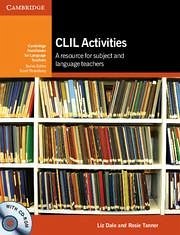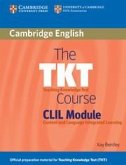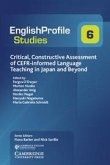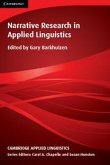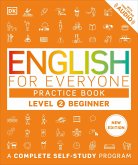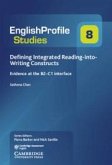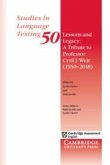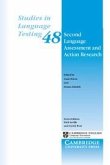- Broschiertes Buch
- Merkliste
- Auf die Merkliste
- Bewerten Bewerten
- Teilen
- Produkt teilen
- Produkterinnerung
- Produkterinnerung
CLIL Activities is organised into five chapters: Activating, Guiding understanding, Focus on language, Focus on speaking and Focus on writing. A further chapter provides practical ideas for assessment, review and feedback. The Background to CLIL section offers a clear explanation of what CLIL is and its benefits and challenges. Dedicated subject pages include annotated extracts from authentic school teaching materials, demonstrating how language is used in the following subjects: Art, Design and Technology, Economics and Business Studies, Geography, History, ICT, Maths, Music and Drama,…mehr
Andere Kunden interessierten sich auch für
![The Tkt Course CLIL Module The Tkt Course CLIL Module]() Kay BentleyThe Tkt Course CLIL Module33,99 €
Kay BentleyThe Tkt Course CLIL Module33,99 €![Critical, Constructive Assessment of CEFR-informed Language Teaching in Japan and Beyond Critical, Constructive Assessment of CEFR-informed Language Teaching in Japan and Beyond]() Critical, Constructive Assessment of CEFR-informed Language Teaching in Japan and Beyond100,99 €
Critical, Constructive Assessment of CEFR-informed Language Teaching in Japan and Beyond100,99 €![Narrative Research in Applied Linguistics Narrative Research in Applied Linguistics]() Gary BarkhuizenNarrative Research in Applied Linguistics61,99 €
Gary BarkhuizenNarrative Research in Applied Linguistics61,99 €![English for Everyone Practice Book Level 2 Beginner English for Everyone Practice Book Level 2 Beginner]() DkEnglish for Everyone Practice Book Level 2 Beginner13,99 €
DkEnglish for Everyone Practice Book Level 2 Beginner13,99 €![Defining Integrated Reading-Into-Writing Constructs Defining Integrated Reading-Into-Writing Constructs]() Sathena ChanDefining Integrated Reading-Into-Writing Constructs91,99 €
Sathena ChanDefining Integrated Reading-Into-Writing Constructs91,99 €![Lessons and Legacy: A Tribute to Professor Cyril J Weir (1950-2018) Lessons and Legacy: A Tribute to Professor Cyril J Weir (1950-2018)]() Lessons and Legacy: A Tribute to Professor Cyril J Weir (1950-2018)95,99 €
Lessons and Legacy: A Tribute to Professor Cyril J Weir (1950-2018)95,99 €![Second Language Assessment and Action Research Second Language Assessment and Action Research]() Second Language Assessment and Action Research91,99 €
Second Language Assessment and Action Research91,99 €-
-
-
CLIL Activities is organised into five chapters: Activating, Guiding understanding, Focus on language, Focus on speaking and Focus on writing. A further chapter provides practical ideas for assessment, review and feedback. The Background to CLIL section offers a clear explanation of what CLIL is and its benefits and challenges. Dedicated subject pages include annotated extracts from authentic school teaching materials, demonstrating how language is used in the following subjects: Art, Design and Technology, Economics and Business Studies, Geography, History, ICT, Maths, Music and Drama, Physical Education and Science. The accompanying CD-ROM contains print-ready CLIL activities.
Hinweis: Dieser Artikel kann nur an eine deutsche Lieferadresse ausgeliefert werden.
Hinweis: Dieser Artikel kann nur an eine deutsche Lieferadresse ausgeliefert werden.
Produktdetails
- Produktdetails
- Verlag: Cambridge-Hitachi
- Seitenzahl: 294
- Erscheinungstermin: 15. März 2012
- Englisch
- Abmessung: 244mm x 191mm x 22mm
- Gewicht: 621g
- ISBN-13: 9780521149846
- ISBN-10: 0521149843
- Artikelnr.: 34540442
- Herstellerkennzeichnung
- Libri GmbH
- Europaallee 1
- 36244 Bad Hersfeld
- gpsr@libri.de
- Verlag: Cambridge-Hitachi
- Seitenzahl: 294
- Erscheinungstermin: 15. März 2012
- Englisch
- Abmessung: 244mm x 191mm x 22mm
- Gewicht: 621g
- ISBN-13: 9780521149846
- ISBN-10: 0521149843
- Artikelnr.: 34540442
- Herstellerkennzeichnung
- Libri GmbH
- Europaallee 1
- 36244 Bad Hersfeld
- gpsr@libri.de
Thanks. Acknowledgments. Introduction. PART 1 BACKGROUND TO CLIL What is
CLIL? CLIL, content-based language teaching (CBLT) and immersion. Teaching
in another language versus teaching through another language. CLIL
snapshots. Benefits of CLIL: why is integrating content and a language a
good thing? Benefits for learners. Benefits for teachers and schools. The
CLIL teacher's role. How 'CLIL' are you? CLIL teachers: new roles. New
roles: CLIL subject teachers. New roles: CLIL language teachers.
Collaboration between language and subject teachers. Rubric 'Collaboration
in CLIL'. Challenges in CLIL. Who is this book for? PART 2 SUBJECT PAGES
Introduction. Challenges for CLIL learners. CLIL in subject teaching. How
to use the subject pages. Features of the subject pages. Art, design and
technology. Economics and business studies. Geography. History. Information
and communication technology (ICT). Maths. Music and drama. Physical
education (PE). Science. PART 3 PRACTICAL ACTIVITIES 1. ACTIVATING. 1.1
Finish the sentence. 1.2 Graphic organisers for activating (1) Venn
diagram. 1.3 Graphic organisers for activating (2) target practice. 1.4
Graphic organisers for activating (3) spider diagram. 1.5 Guessing the
lesson. 1.6 Hands-on discovering. 1.7 KWL (know, want, learn) grid. 1.8
Newsy newspapers. 1.9 Placemat. 1.10 Quickest, most, best. 1.11 Red and
green circles. 1.12 Researching the lesson. 1.13 Scrambled eggs. 1.14 Vital
visuals. 1.15 Word wall. 2. GUIDING UNDERSTANDING. 2.1 Expert groups. 2.2
Gist statements. 2.3 Graffiti. 2.4 Graphic organisers. 2.5 Interactive
PowerPoint. 2.6 Interview as input. 2.7 Jumbles. 2.8 Learner-generated
questions. 2.9 Listening questions. 2.10 Mind the gap. 2.11 Running
commentary. 2.12 Skinny and fat questions and thinking skills. 2.13
Subheadings. 2.14 Understanding new words. 2.15 What was the question? 3.
FOCUS ON LANGUAGE. 3.1 Academic word list. 3.2 Bingo. 3.3 Guess the word.
3.4 Hot seat. 3.5 Matching trios. 3.6 Mind maps. 3.7 Mnemonics. 3.8
Noticing. 3.9 Odd one out. 3.10 Personal vocabulary file or glossary. 3.11
Ranking. 3.12 Snake. 3.13 Sorting. 3.14 Taboo. 3.15 Vocabulary posters.
3.16 Vocabulary strategies. 3.17 Word association. 3.18 Word puzzle. 3.19
Word stories. 4. FOCUS ON SPEAKING. 4.1 Balloon debate. 4.2 Describe and
draw. 4.3 Eyewitness. 4.4 Information gaps. 4.5 Living gaps. 4.6 Problems,
problems. 4.7 Prove it. 4.8 Ranking cards. 4.9 Role play: job interview.
4.10 Rubric jigsaw for presentations. 4.11 Speak for an audience. 4.12
Speaking frames. 4.13 Think, Pair, Share. 4.14 Vivid visuals. 5. FOCUS ON
WRITING. 5.1 Advice Column. 5.2 Aliens. 5.3 Brainstorming for writing (1)
posters. 5.4 Brainstorming for writing (2) focused free writing. 5.5 Class
magazine. 5.6 Framing writing. 5.7 I am a... 5.8 Instructions. 5.9 Lost in
conversion. 5.10 Questions to paragraph. 5.11 Recreate a text. 5.12
Real-life writing. 5.13 Storyboard. 5.14 Visuals. 6. ASSESSMENT, REVIEW AND
FEEDBACK. 6.1 Assessment questions. 6.2 Complete a rubric. 6.3 Correction
code. 6.4 Correction cards. 6.5 First person revision. 6.6 Group
self-evaluation. 6.7 Jigsaw rubric: assessing speaking. 6.8 Language
feedback. 6.9 Multiple intelligences: exploring. 6.10 Multiple
intelligences: assessment. 6.11 Rewrite together. 6.12 Revision circles.
6.13 Stickers. 6.14 Visual assessments. References and further reading.
Appendix: The Common European Framework of Reference for Languages. Index.
CLIL? CLIL, content-based language teaching (CBLT) and immersion. Teaching
in another language versus teaching through another language. CLIL
snapshots. Benefits of CLIL: why is integrating content and a language a
good thing? Benefits for learners. Benefits for teachers and schools. The
CLIL teacher's role. How 'CLIL' are you? CLIL teachers: new roles. New
roles: CLIL subject teachers. New roles: CLIL language teachers.
Collaboration between language and subject teachers. Rubric 'Collaboration
in CLIL'. Challenges in CLIL. Who is this book for? PART 2 SUBJECT PAGES
Introduction. Challenges for CLIL learners. CLIL in subject teaching. How
to use the subject pages. Features of the subject pages. Art, design and
technology. Economics and business studies. Geography. History. Information
and communication technology (ICT). Maths. Music and drama. Physical
education (PE). Science. PART 3 PRACTICAL ACTIVITIES 1. ACTIVATING. 1.1
Finish the sentence. 1.2 Graphic organisers for activating (1) Venn
diagram. 1.3 Graphic organisers for activating (2) target practice. 1.4
Graphic organisers for activating (3) spider diagram. 1.5 Guessing the
lesson. 1.6 Hands-on discovering. 1.7 KWL (know, want, learn) grid. 1.8
Newsy newspapers. 1.9 Placemat. 1.10 Quickest, most, best. 1.11 Red and
green circles. 1.12 Researching the lesson. 1.13 Scrambled eggs. 1.14 Vital
visuals. 1.15 Word wall. 2. GUIDING UNDERSTANDING. 2.1 Expert groups. 2.2
Gist statements. 2.3 Graffiti. 2.4 Graphic organisers. 2.5 Interactive
PowerPoint. 2.6 Interview as input. 2.7 Jumbles. 2.8 Learner-generated
questions. 2.9 Listening questions. 2.10 Mind the gap. 2.11 Running
commentary. 2.12 Skinny and fat questions and thinking skills. 2.13
Subheadings. 2.14 Understanding new words. 2.15 What was the question? 3.
FOCUS ON LANGUAGE. 3.1 Academic word list. 3.2 Bingo. 3.3 Guess the word.
3.4 Hot seat. 3.5 Matching trios. 3.6 Mind maps. 3.7 Mnemonics. 3.8
Noticing. 3.9 Odd one out. 3.10 Personal vocabulary file or glossary. 3.11
Ranking. 3.12 Snake. 3.13 Sorting. 3.14 Taboo. 3.15 Vocabulary posters.
3.16 Vocabulary strategies. 3.17 Word association. 3.18 Word puzzle. 3.19
Word stories. 4. FOCUS ON SPEAKING. 4.1 Balloon debate. 4.2 Describe and
draw. 4.3 Eyewitness. 4.4 Information gaps. 4.5 Living gaps. 4.6 Problems,
problems. 4.7 Prove it. 4.8 Ranking cards. 4.9 Role play: job interview.
4.10 Rubric jigsaw for presentations. 4.11 Speak for an audience. 4.12
Speaking frames. 4.13 Think, Pair, Share. 4.14 Vivid visuals. 5. FOCUS ON
WRITING. 5.1 Advice Column. 5.2 Aliens. 5.3 Brainstorming for writing (1)
posters. 5.4 Brainstorming for writing (2) focused free writing. 5.5 Class
magazine. 5.6 Framing writing. 5.7 I am a... 5.8 Instructions. 5.9 Lost in
conversion. 5.10 Questions to paragraph. 5.11 Recreate a text. 5.12
Real-life writing. 5.13 Storyboard. 5.14 Visuals. 6. ASSESSMENT, REVIEW AND
FEEDBACK. 6.1 Assessment questions. 6.2 Complete a rubric. 6.3 Correction
code. 6.4 Correction cards. 6.5 First person revision. 6.6 Group
self-evaluation. 6.7 Jigsaw rubric: assessing speaking. 6.8 Language
feedback. 6.9 Multiple intelligences: exploring. 6.10 Multiple
intelligences: assessment. 6.11 Rewrite together. 6.12 Revision circles.
6.13 Stickers. 6.14 Visual assessments. References and further reading.
Appendix: The Common European Framework of Reference for Languages. Index.
Thanks. Acknowledgments. Introduction. PART 1 BACKGROUND TO CLIL What is
CLIL? CLIL, content-based language teaching (CBLT) and immersion. Teaching
in another language versus teaching through another language. CLIL
snapshots. Benefits of CLIL: why is integrating content and a language a
good thing? Benefits for learners. Benefits for teachers and schools. The
CLIL teacher's role. How 'CLIL' are you? CLIL teachers: new roles. New
roles: CLIL subject teachers. New roles: CLIL language teachers.
Collaboration between language and subject teachers. Rubric 'Collaboration
in CLIL'. Challenges in CLIL. Who is this book for? PART 2 SUBJECT PAGES
Introduction. Challenges for CLIL learners. CLIL in subject teaching. How
to use the subject pages. Features of the subject pages. Art, design and
technology. Economics and business studies. Geography. History. Information
and communication technology (ICT). Maths. Music and drama. Physical
education (PE). Science. PART 3 PRACTICAL ACTIVITIES 1. ACTIVATING. 1.1
Finish the sentence. 1.2 Graphic organisers for activating (1) Venn
diagram. 1.3 Graphic organisers for activating (2) target practice. 1.4
Graphic organisers for activating (3) spider diagram. 1.5 Guessing the
lesson. 1.6 Hands-on discovering. 1.7 KWL (know, want, learn) grid. 1.8
Newsy newspapers. 1.9 Placemat. 1.10 Quickest, most, best. 1.11 Red and
green circles. 1.12 Researching the lesson. 1.13 Scrambled eggs. 1.14 Vital
visuals. 1.15 Word wall. 2. GUIDING UNDERSTANDING. 2.1 Expert groups. 2.2
Gist statements. 2.3 Graffiti. 2.4 Graphic organisers. 2.5 Interactive
PowerPoint. 2.6 Interview as input. 2.7 Jumbles. 2.8 Learner-generated
questions. 2.9 Listening questions. 2.10 Mind the gap. 2.11 Running
commentary. 2.12 Skinny and fat questions and thinking skills. 2.13
Subheadings. 2.14 Understanding new words. 2.15 What was the question? 3.
FOCUS ON LANGUAGE. 3.1 Academic word list. 3.2 Bingo. 3.3 Guess the word.
3.4 Hot seat. 3.5 Matching trios. 3.6 Mind maps. 3.7 Mnemonics. 3.8
Noticing. 3.9 Odd one out. 3.10 Personal vocabulary file or glossary. 3.11
Ranking. 3.12 Snake. 3.13 Sorting. 3.14 Taboo. 3.15 Vocabulary posters.
3.16 Vocabulary strategies. 3.17 Word association. 3.18 Word puzzle. 3.19
Word stories. 4. FOCUS ON SPEAKING. 4.1 Balloon debate. 4.2 Describe and
draw. 4.3 Eyewitness. 4.4 Information gaps. 4.5 Living gaps. 4.6 Problems,
problems. 4.7 Prove it. 4.8 Ranking cards. 4.9 Role play: job interview.
4.10 Rubric jigsaw for presentations. 4.11 Speak for an audience. 4.12
Speaking frames. 4.13 Think, Pair, Share. 4.14 Vivid visuals. 5. FOCUS ON
WRITING. 5.1 Advice Column. 5.2 Aliens. 5.3 Brainstorming for writing (1)
posters. 5.4 Brainstorming for writing (2) focused free writing. 5.5 Class
magazine. 5.6 Framing writing. 5.7 I am a... 5.8 Instructions. 5.9 Lost in
conversion. 5.10 Questions to paragraph. 5.11 Recreate a text. 5.12
Real-life writing. 5.13 Storyboard. 5.14 Visuals. 6. ASSESSMENT, REVIEW AND
FEEDBACK. 6.1 Assessment questions. 6.2 Complete a rubric. 6.3 Correction
code. 6.4 Correction cards. 6.5 First person revision. 6.6 Group
self-evaluation. 6.7 Jigsaw rubric: assessing speaking. 6.8 Language
feedback. 6.9 Multiple intelligences: exploring. 6.10 Multiple
intelligences: assessment. 6.11 Rewrite together. 6.12 Revision circles.
6.13 Stickers. 6.14 Visual assessments. References and further reading.
Appendix: The Common European Framework of Reference for Languages. Index.
CLIL? CLIL, content-based language teaching (CBLT) and immersion. Teaching
in another language versus teaching through another language. CLIL
snapshots. Benefits of CLIL: why is integrating content and a language a
good thing? Benefits for learners. Benefits for teachers and schools. The
CLIL teacher's role. How 'CLIL' are you? CLIL teachers: new roles. New
roles: CLIL subject teachers. New roles: CLIL language teachers.
Collaboration between language and subject teachers. Rubric 'Collaboration
in CLIL'. Challenges in CLIL. Who is this book for? PART 2 SUBJECT PAGES
Introduction. Challenges for CLIL learners. CLIL in subject teaching. How
to use the subject pages. Features of the subject pages. Art, design and
technology. Economics and business studies. Geography. History. Information
and communication technology (ICT). Maths. Music and drama. Physical
education (PE). Science. PART 3 PRACTICAL ACTIVITIES 1. ACTIVATING. 1.1
Finish the sentence. 1.2 Graphic organisers for activating (1) Venn
diagram. 1.3 Graphic organisers for activating (2) target practice. 1.4
Graphic organisers for activating (3) spider diagram. 1.5 Guessing the
lesson. 1.6 Hands-on discovering. 1.7 KWL (know, want, learn) grid. 1.8
Newsy newspapers. 1.9 Placemat. 1.10 Quickest, most, best. 1.11 Red and
green circles. 1.12 Researching the lesson. 1.13 Scrambled eggs. 1.14 Vital
visuals. 1.15 Word wall. 2. GUIDING UNDERSTANDING. 2.1 Expert groups. 2.2
Gist statements. 2.3 Graffiti. 2.4 Graphic organisers. 2.5 Interactive
PowerPoint. 2.6 Interview as input. 2.7 Jumbles. 2.8 Learner-generated
questions. 2.9 Listening questions. 2.10 Mind the gap. 2.11 Running
commentary. 2.12 Skinny and fat questions and thinking skills. 2.13
Subheadings. 2.14 Understanding new words. 2.15 What was the question? 3.
FOCUS ON LANGUAGE. 3.1 Academic word list. 3.2 Bingo. 3.3 Guess the word.
3.4 Hot seat. 3.5 Matching trios. 3.6 Mind maps. 3.7 Mnemonics. 3.8
Noticing. 3.9 Odd one out. 3.10 Personal vocabulary file or glossary. 3.11
Ranking. 3.12 Snake. 3.13 Sorting. 3.14 Taboo. 3.15 Vocabulary posters.
3.16 Vocabulary strategies. 3.17 Word association. 3.18 Word puzzle. 3.19
Word stories. 4. FOCUS ON SPEAKING. 4.1 Balloon debate. 4.2 Describe and
draw. 4.3 Eyewitness. 4.4 Information gaps. 4.5 Living gaps. 4.6 Problems,
problems. 4.7 Prove it. 4.8 Ranking cards. 4.9 Role play: job interview.
4.10 Rubric jigsaw for presentations. 4.11 Speak for an audience. 4.12
Speaking frames. 4.13 Think, Pair, Share. 4.14 Vivid visuals. 5. FOCUS ON
WRITING. 5.1 Advice Column. 5.2 Aliens. 5.3 Brainstorming for writing (1)
posters. 5.4 Brainstorming for writing (2) focused free writing. 5.5 Class
magazine. 5.6 Framing writing. 5.7 I am a... 5.8 Instructions. 5.9 Lost in
conversion. 5.10 Questions to paragraph. 5.11 Recreate a text. 5.12
Real-life writing. 5.13 Storyboard. 5.14 Visuals. 6. ASSESSMENT, REVIEW AND
FEEDBACK. 6.1 Assessment questions. 6.2 Complete a rubric. 6.3 Correction
code. 6.4 Correction cards. 6.5 First person revision. 6.6 Group
self-evaluation. 6.7 Jigsaw rubric: assessing speaking. 6.8 Language
feedback. 6.9 Multiple intelligences: exploring. 6.10 Multiple
intelligences: assessment. 6.11 Rewrite together. 6.12 Revision circles.
6.13 Stickers. 6.14 Visual assessments. References and further reading.
Appendix: The Common European Framework of Reference for Languages. Index.

